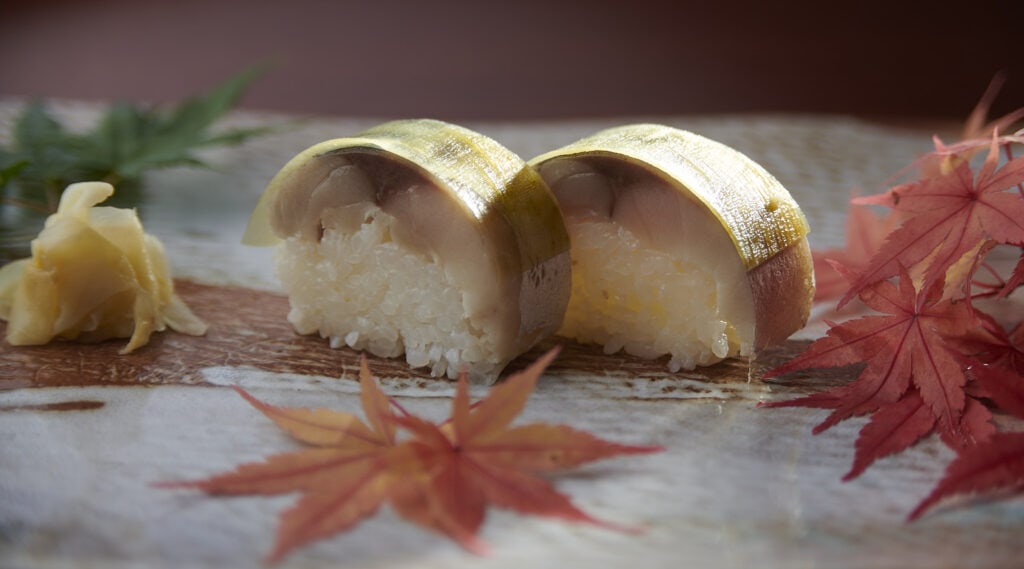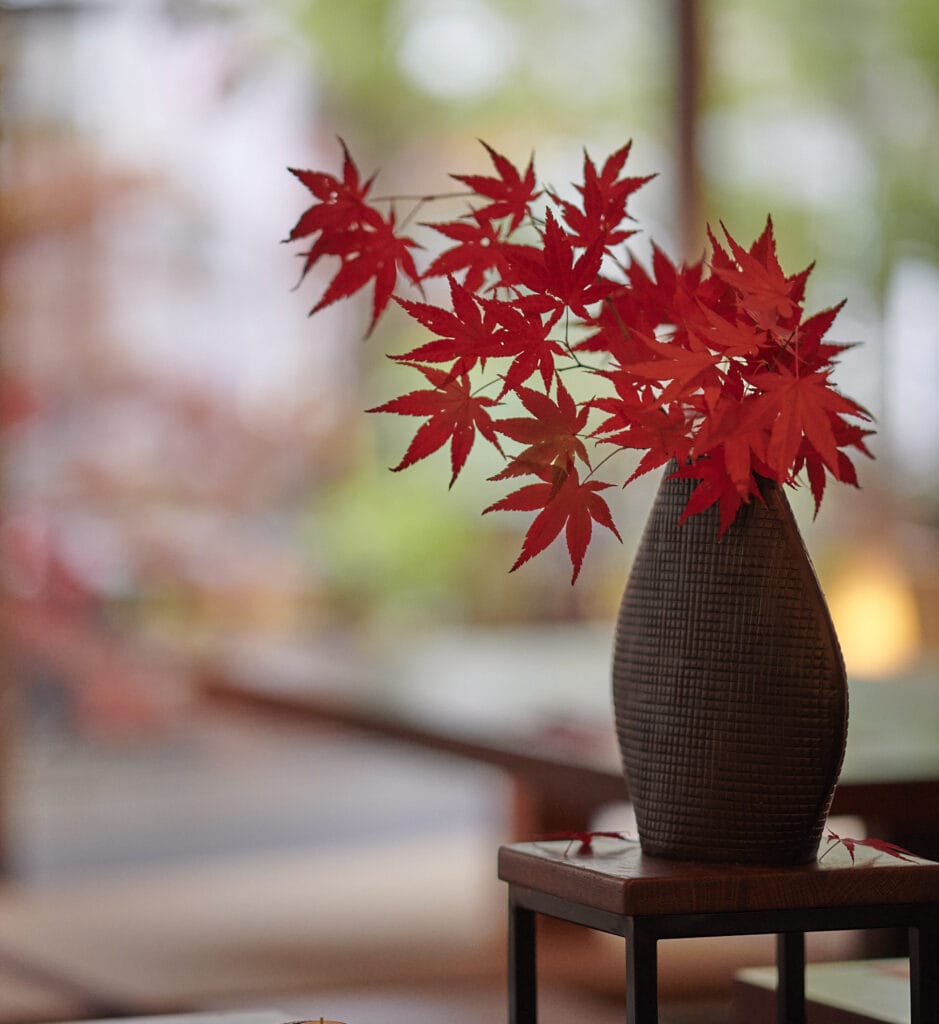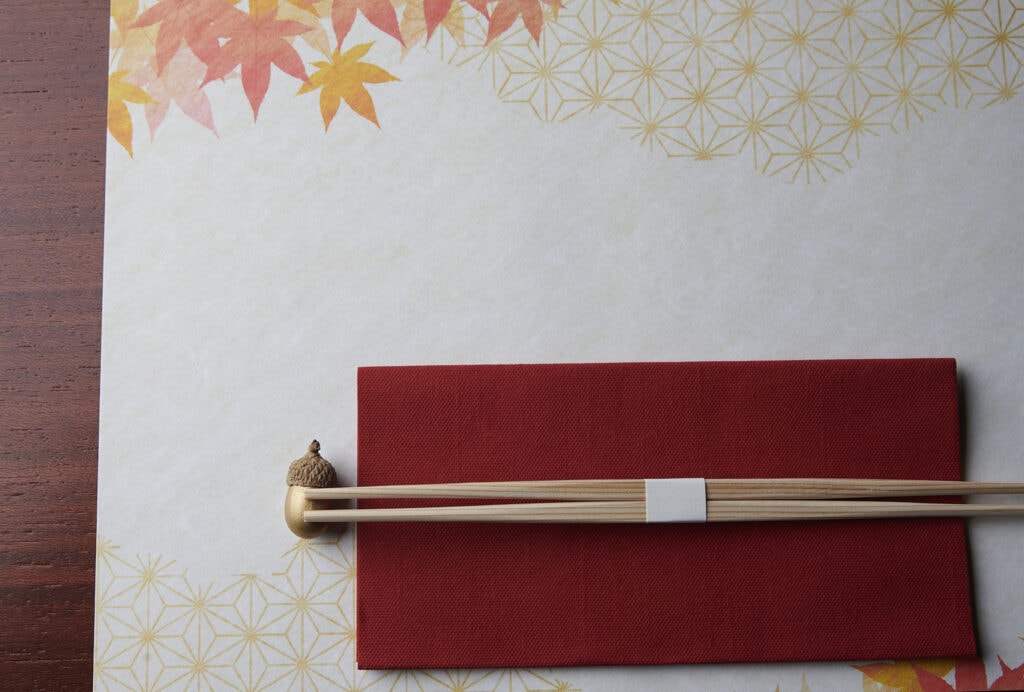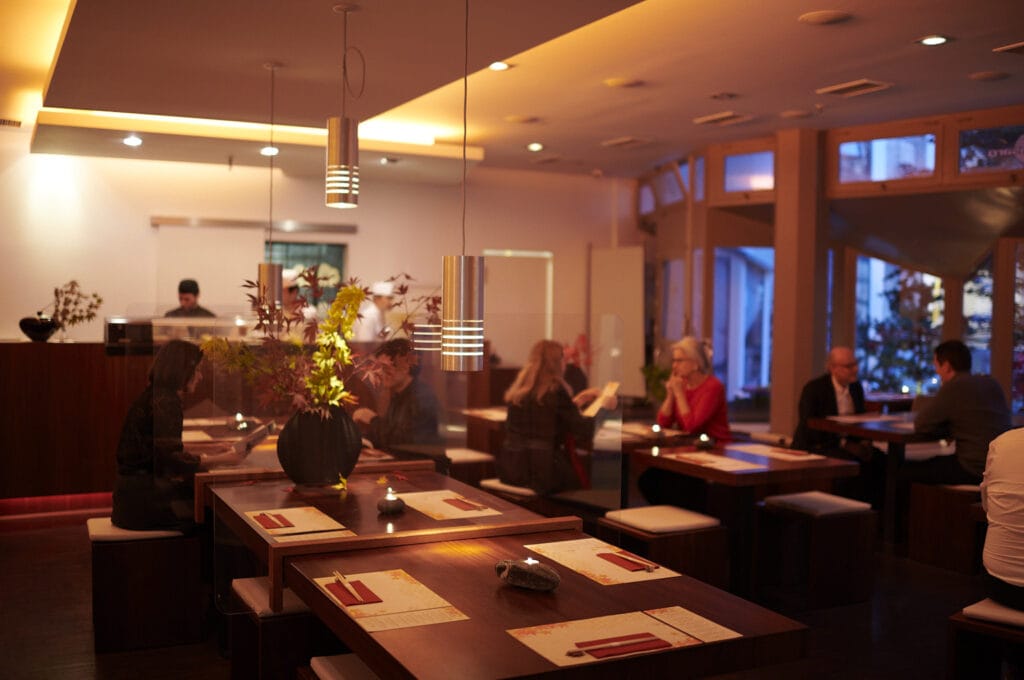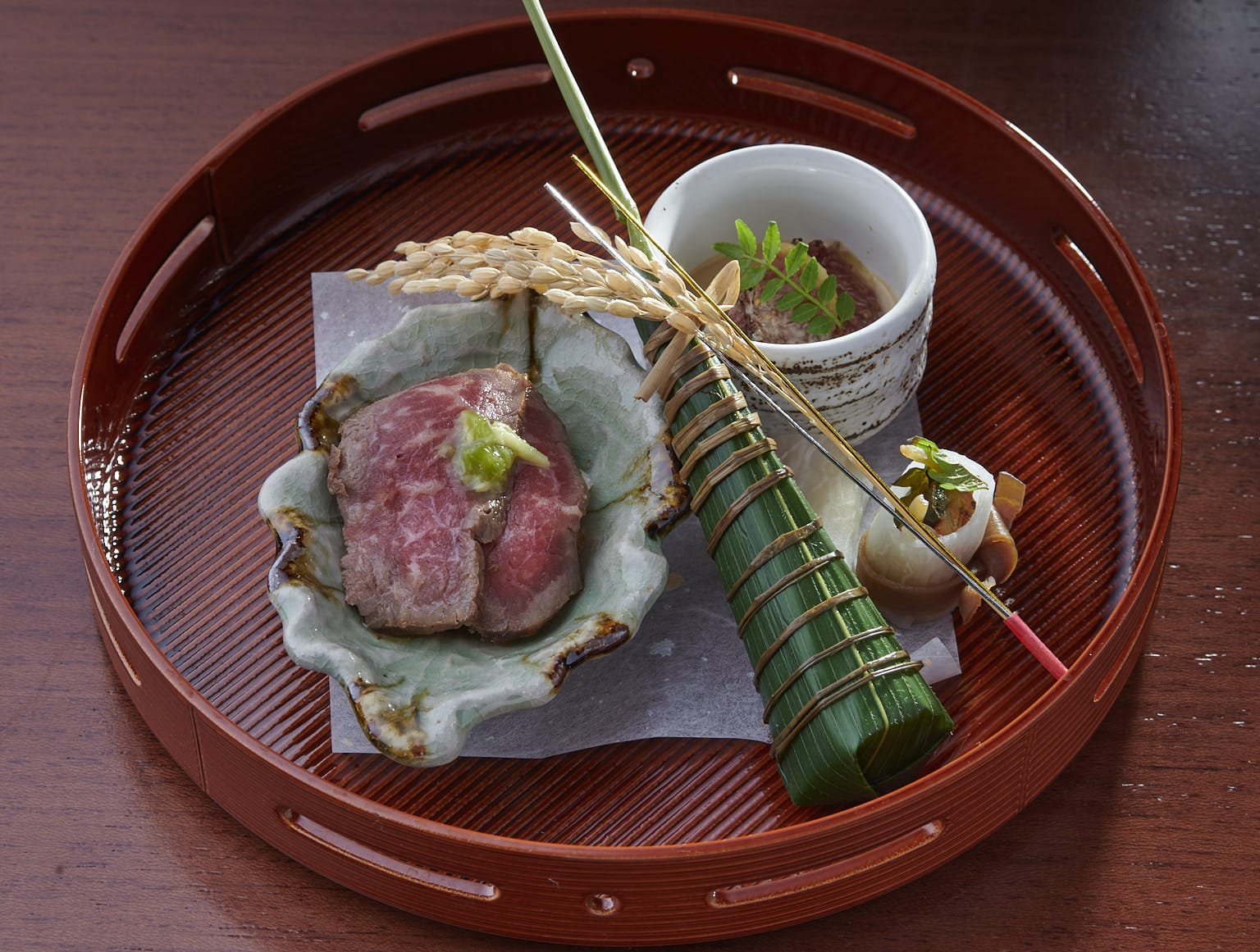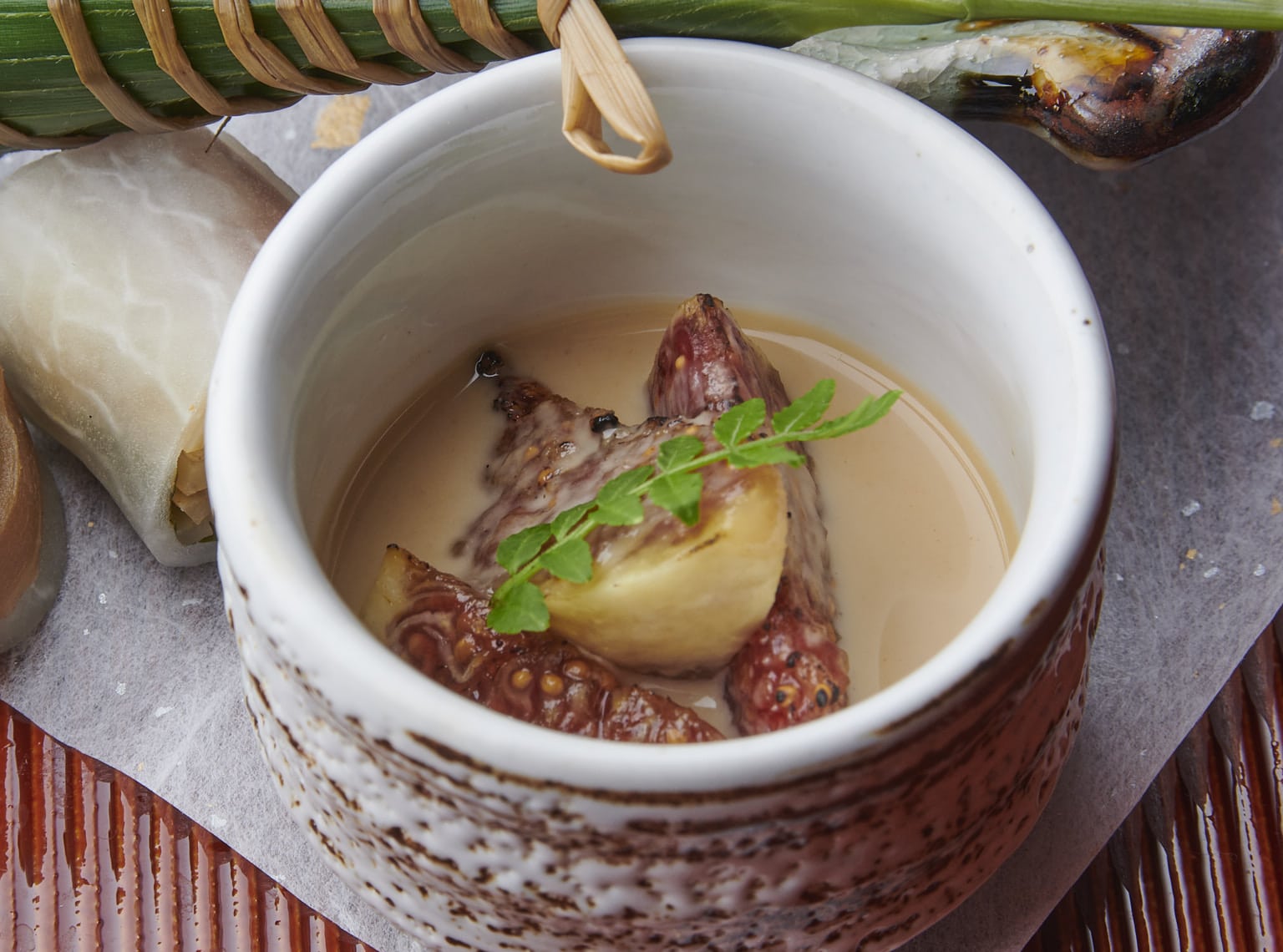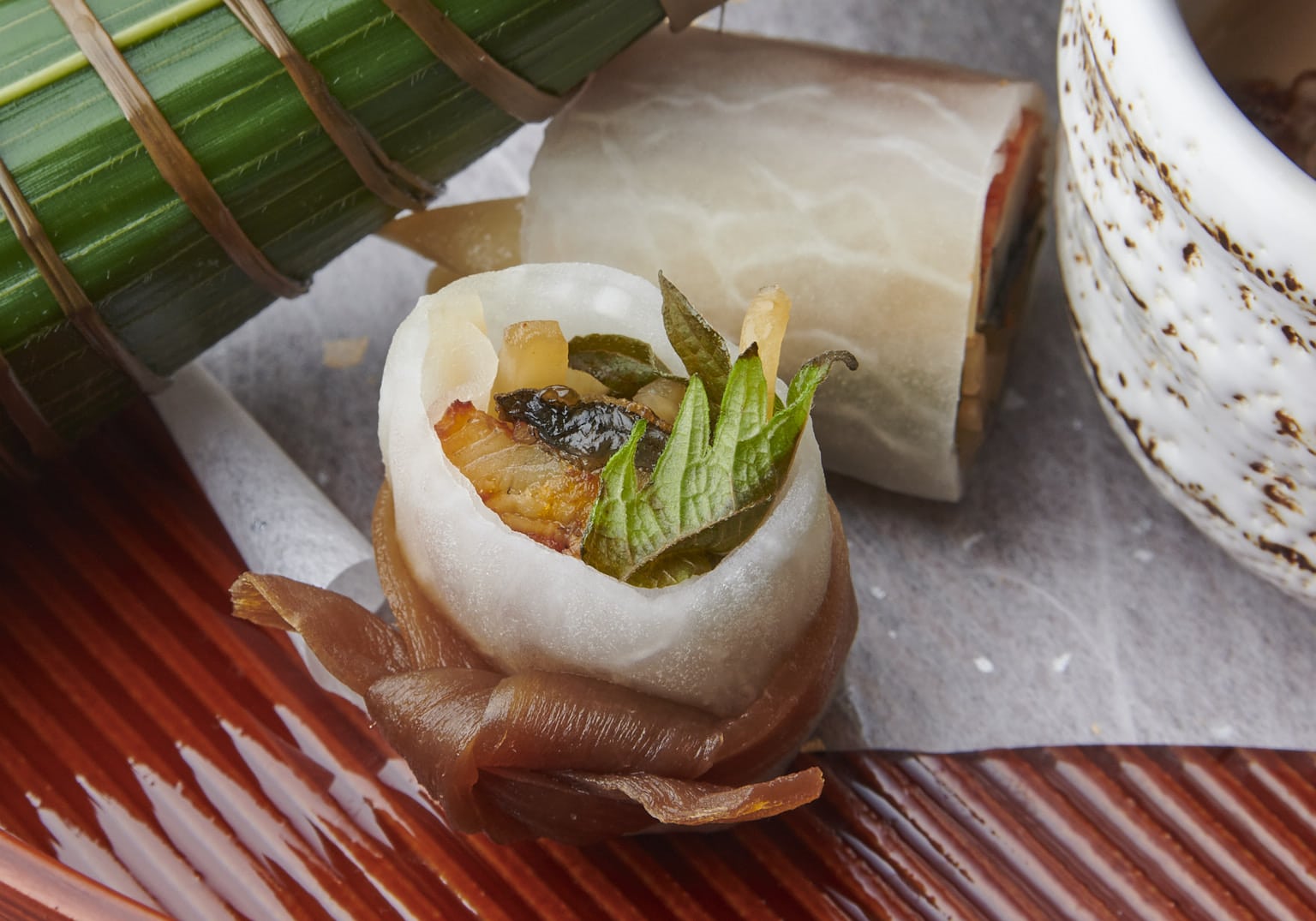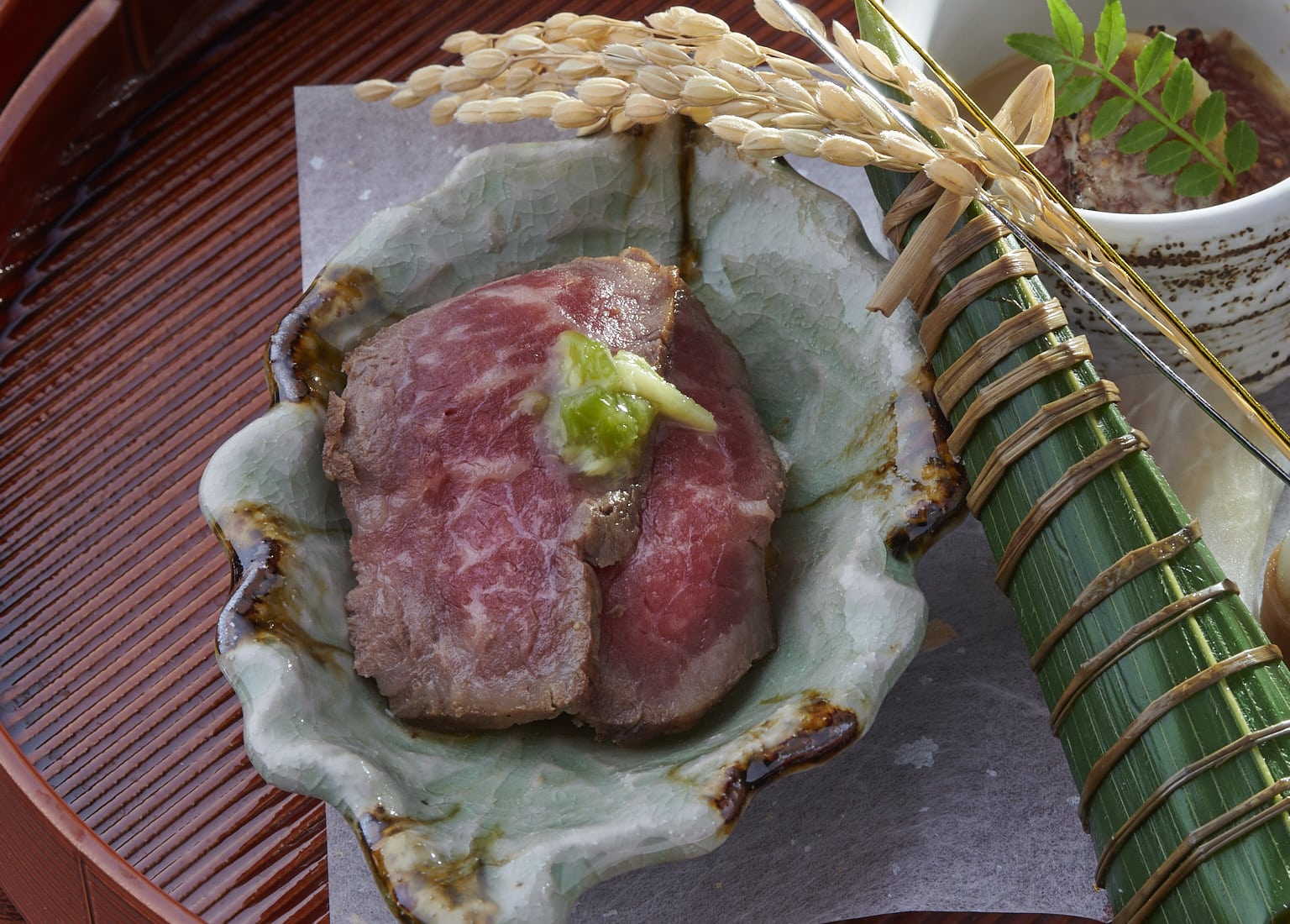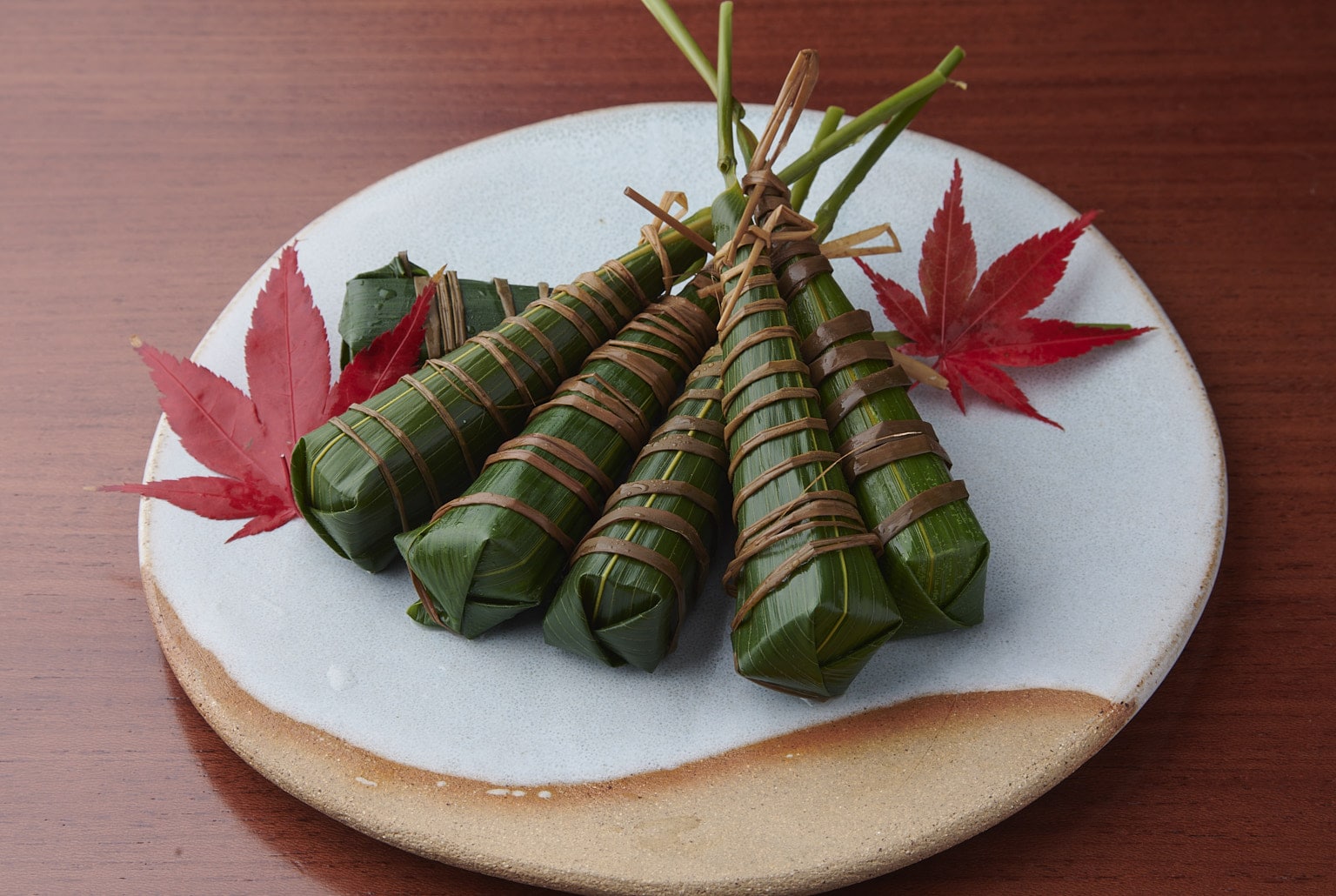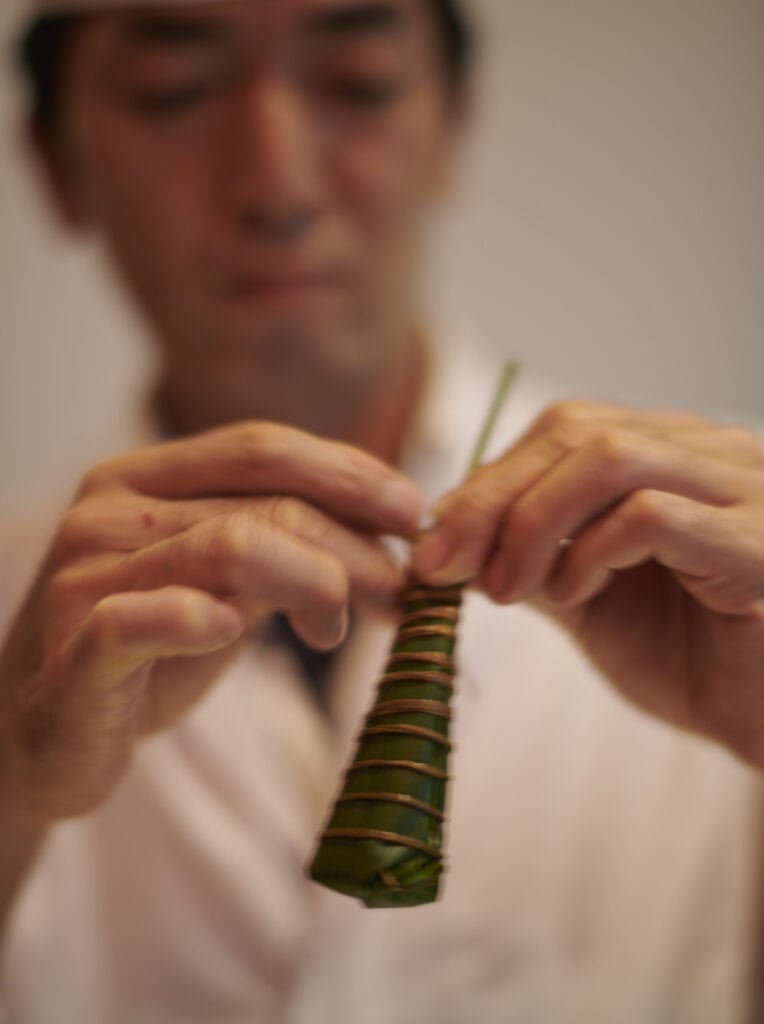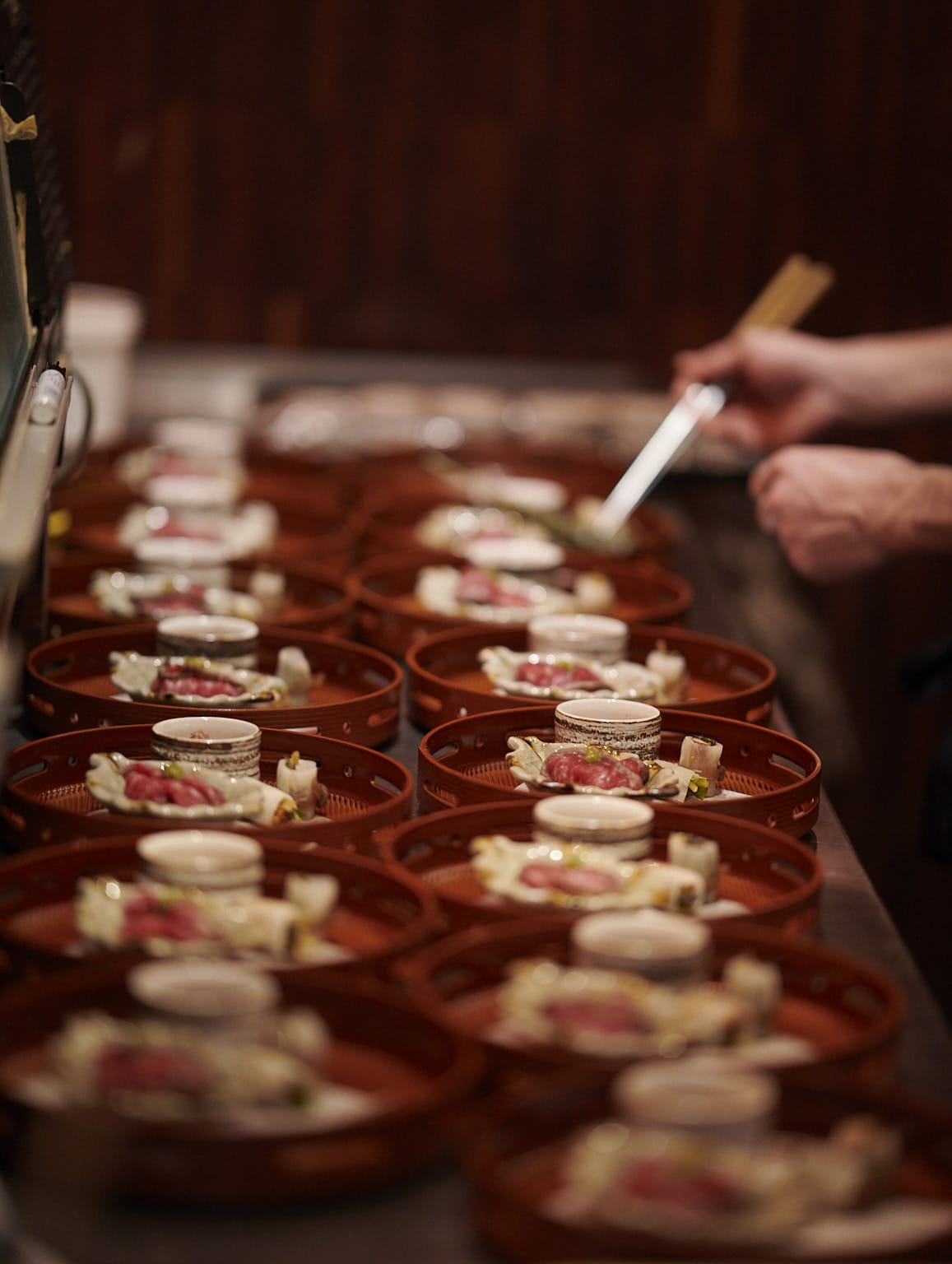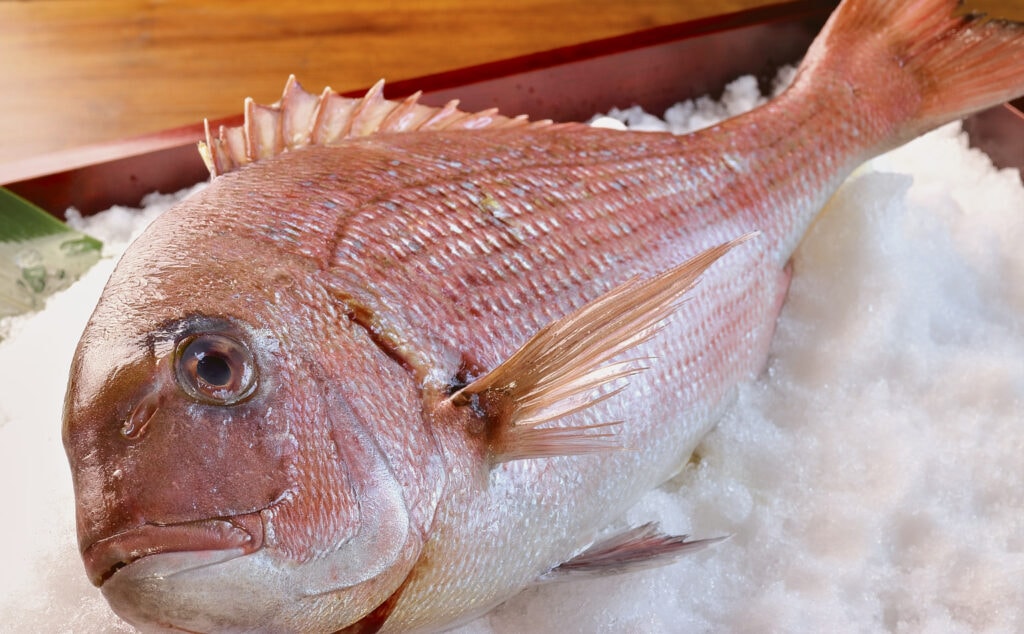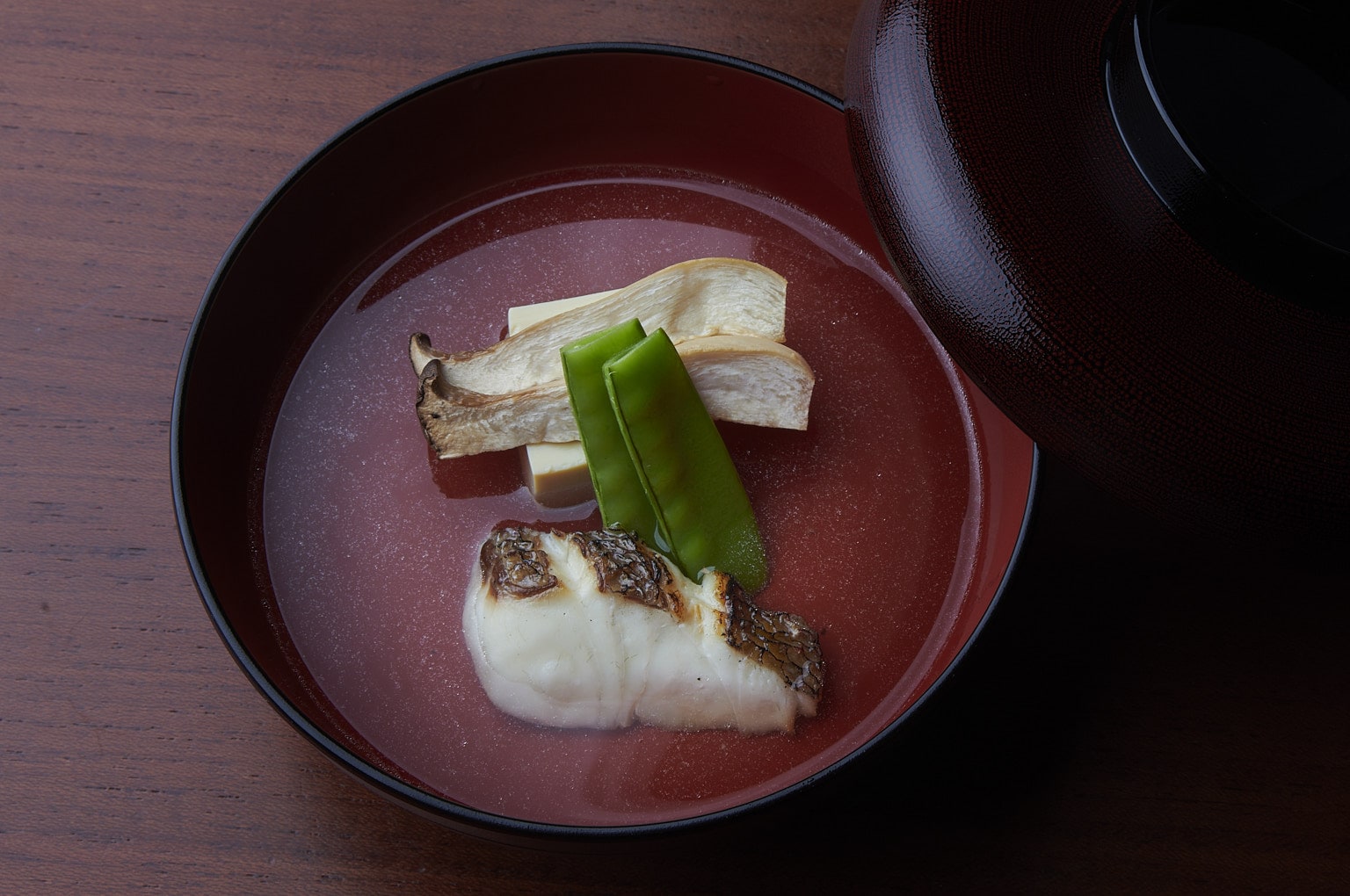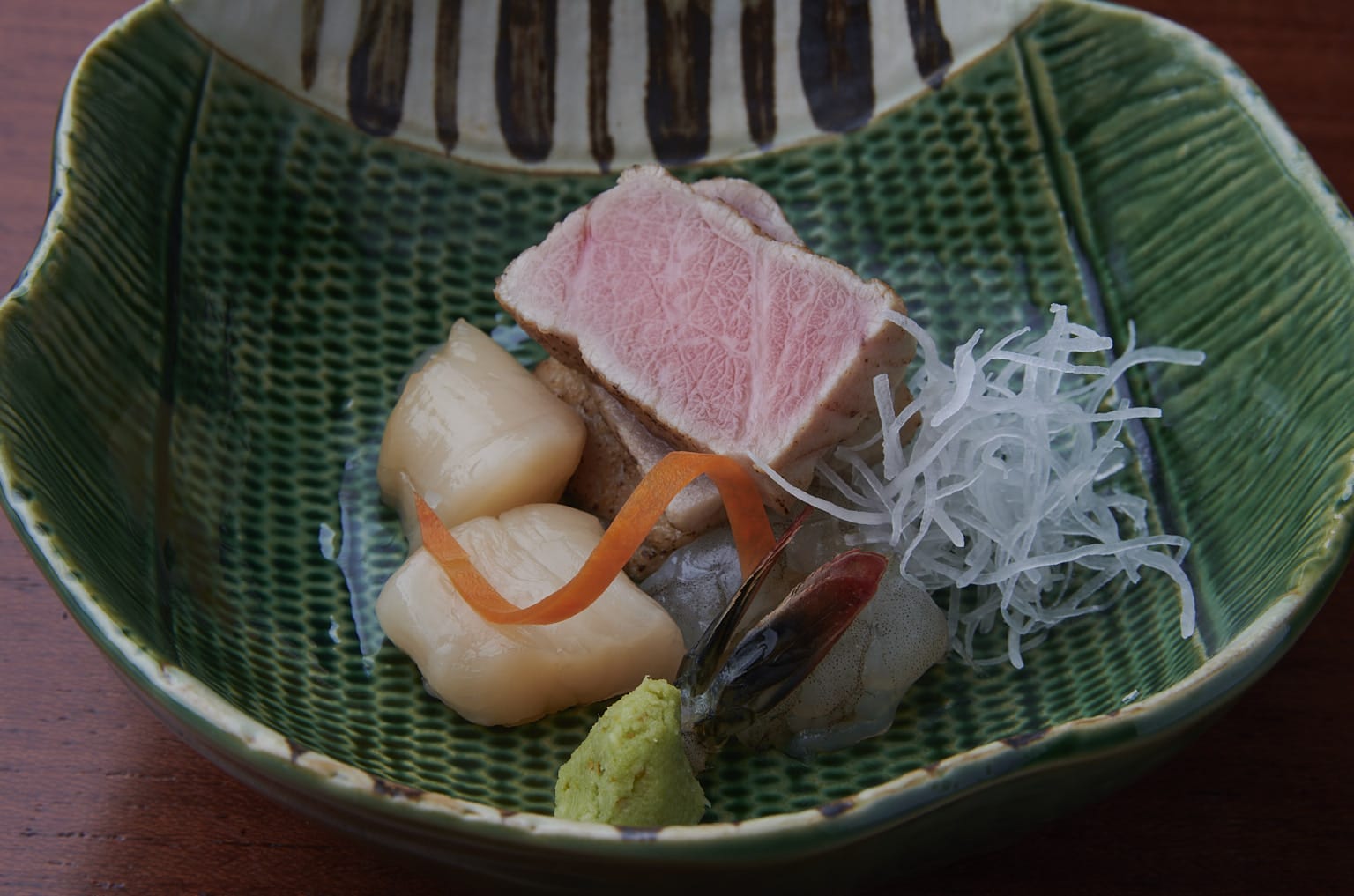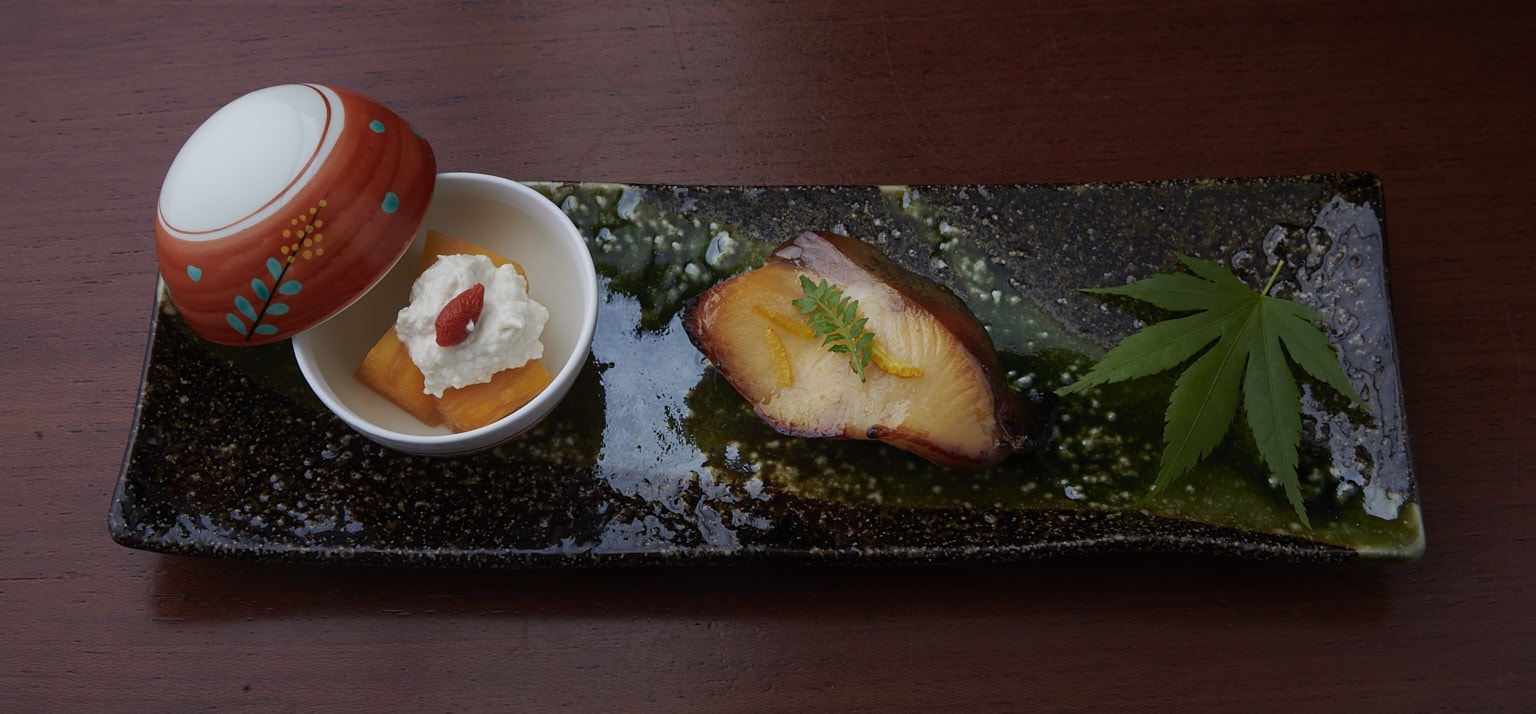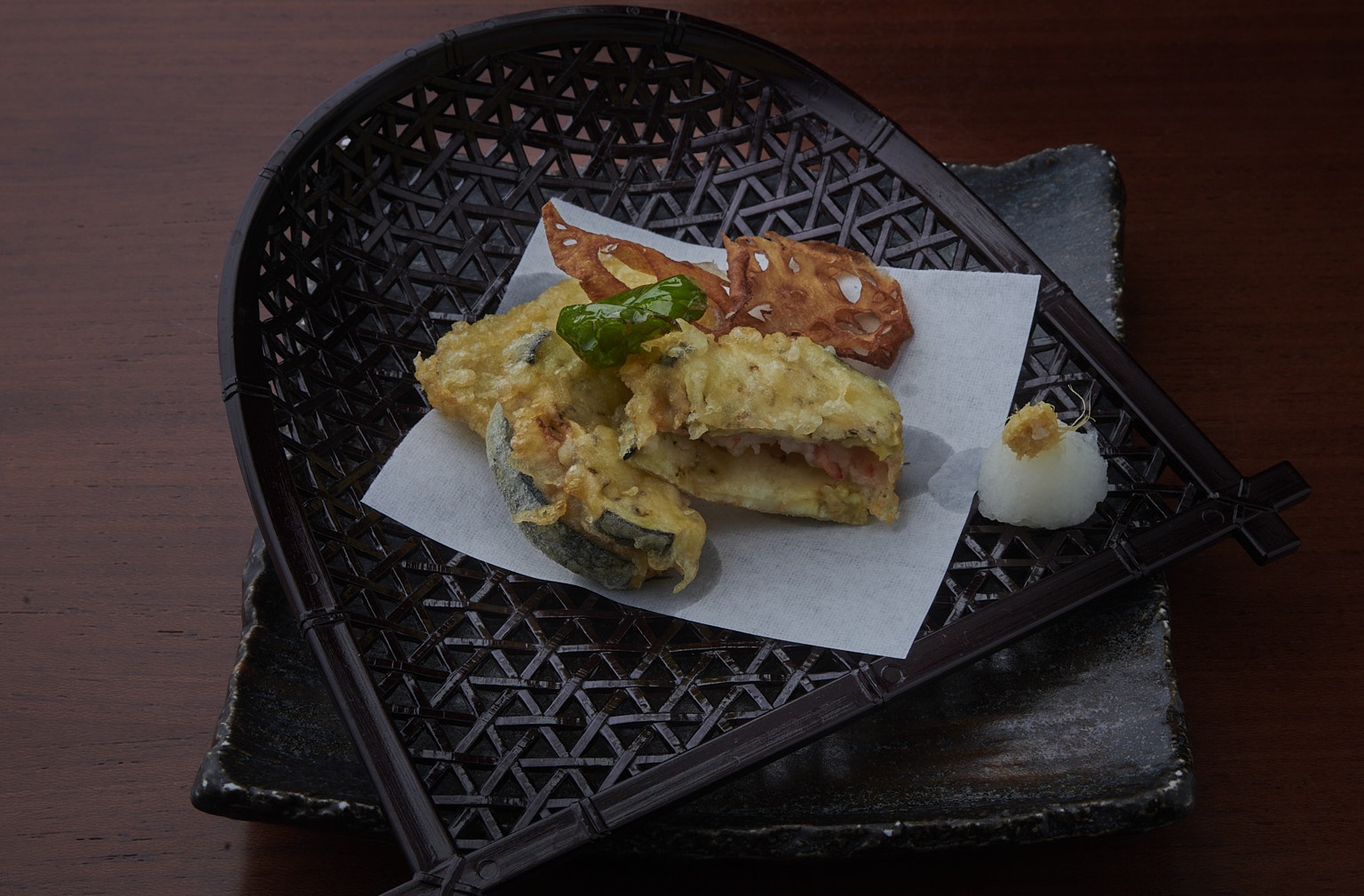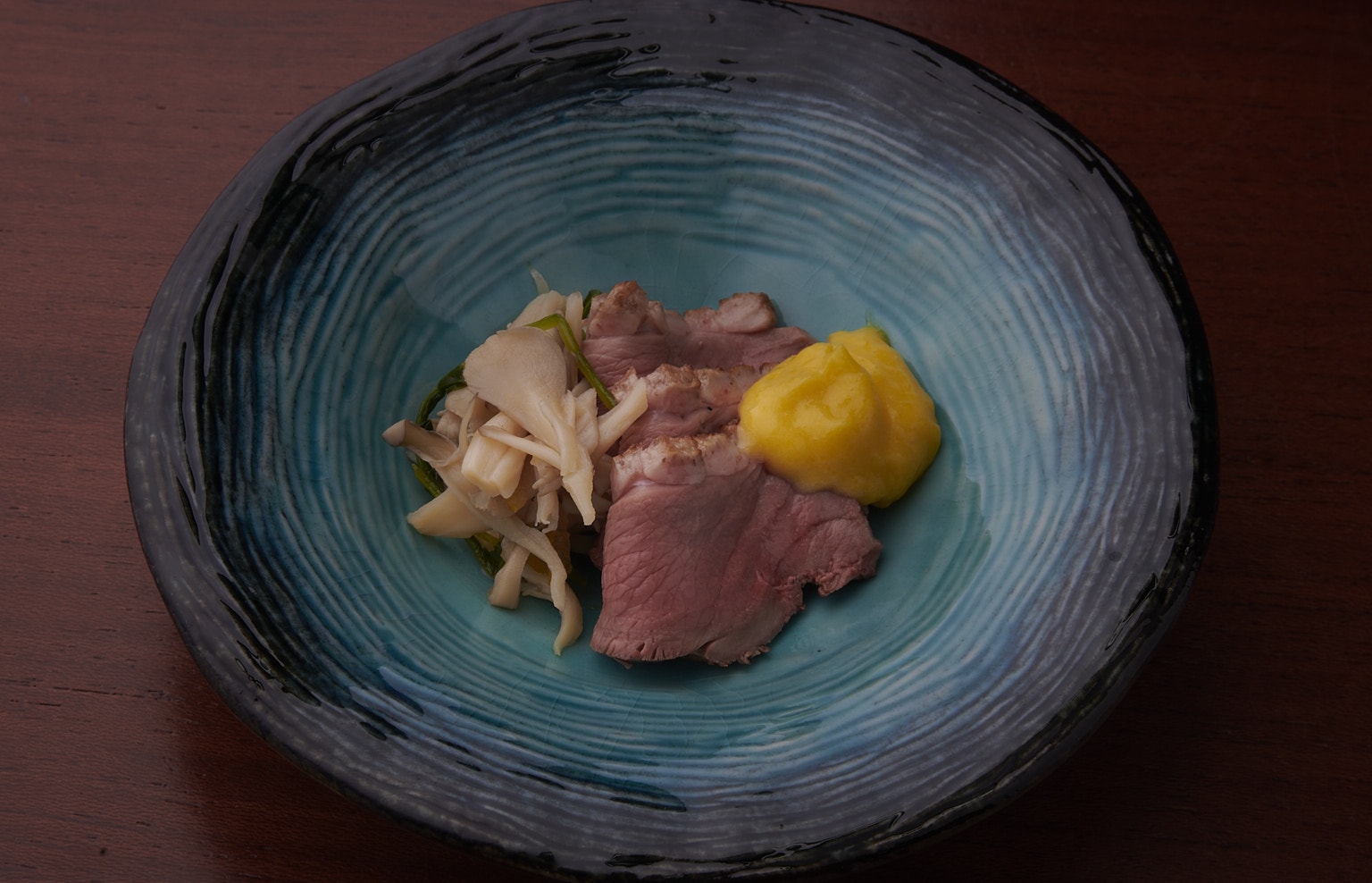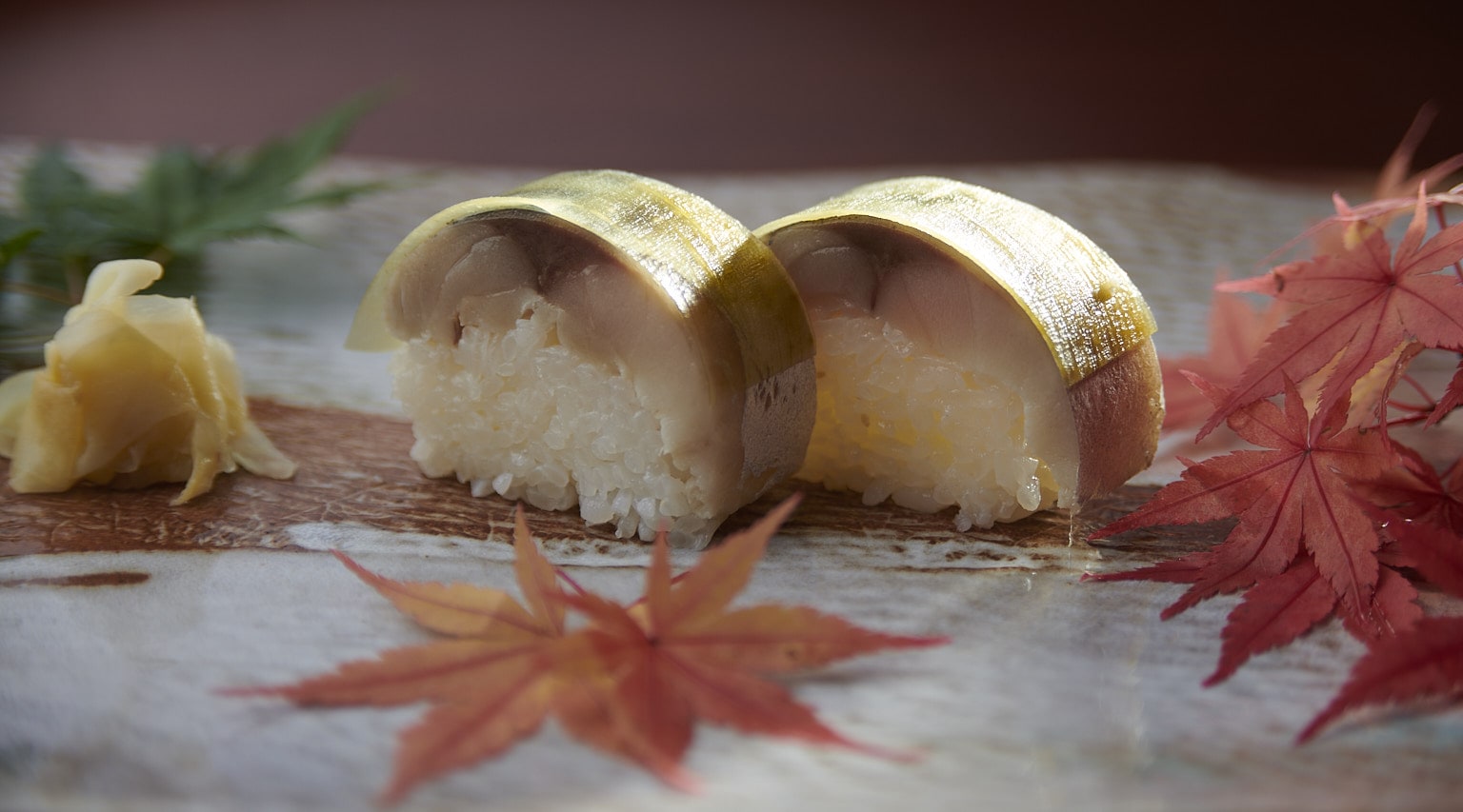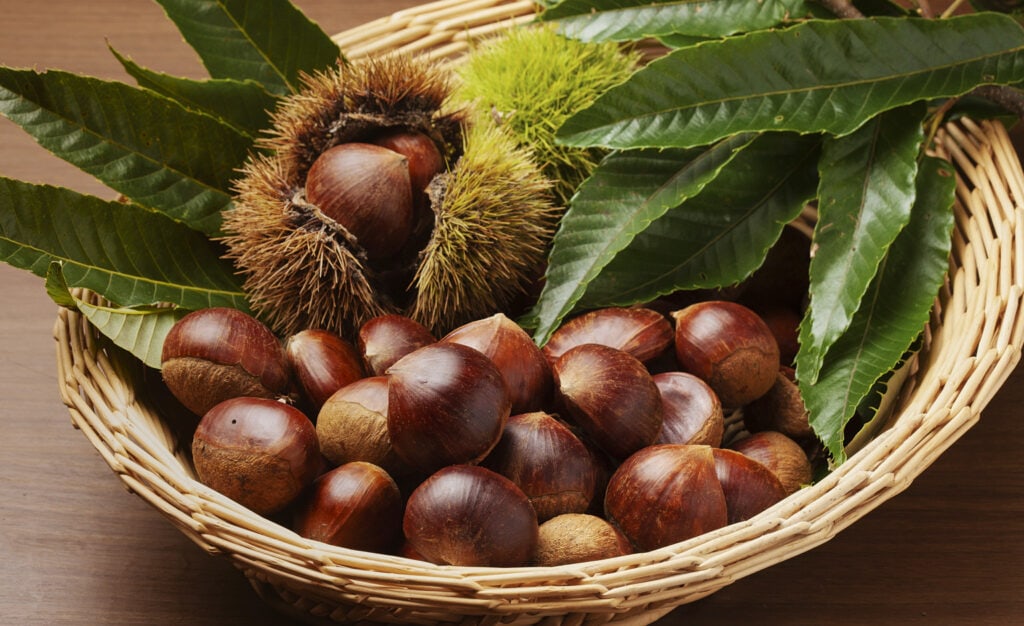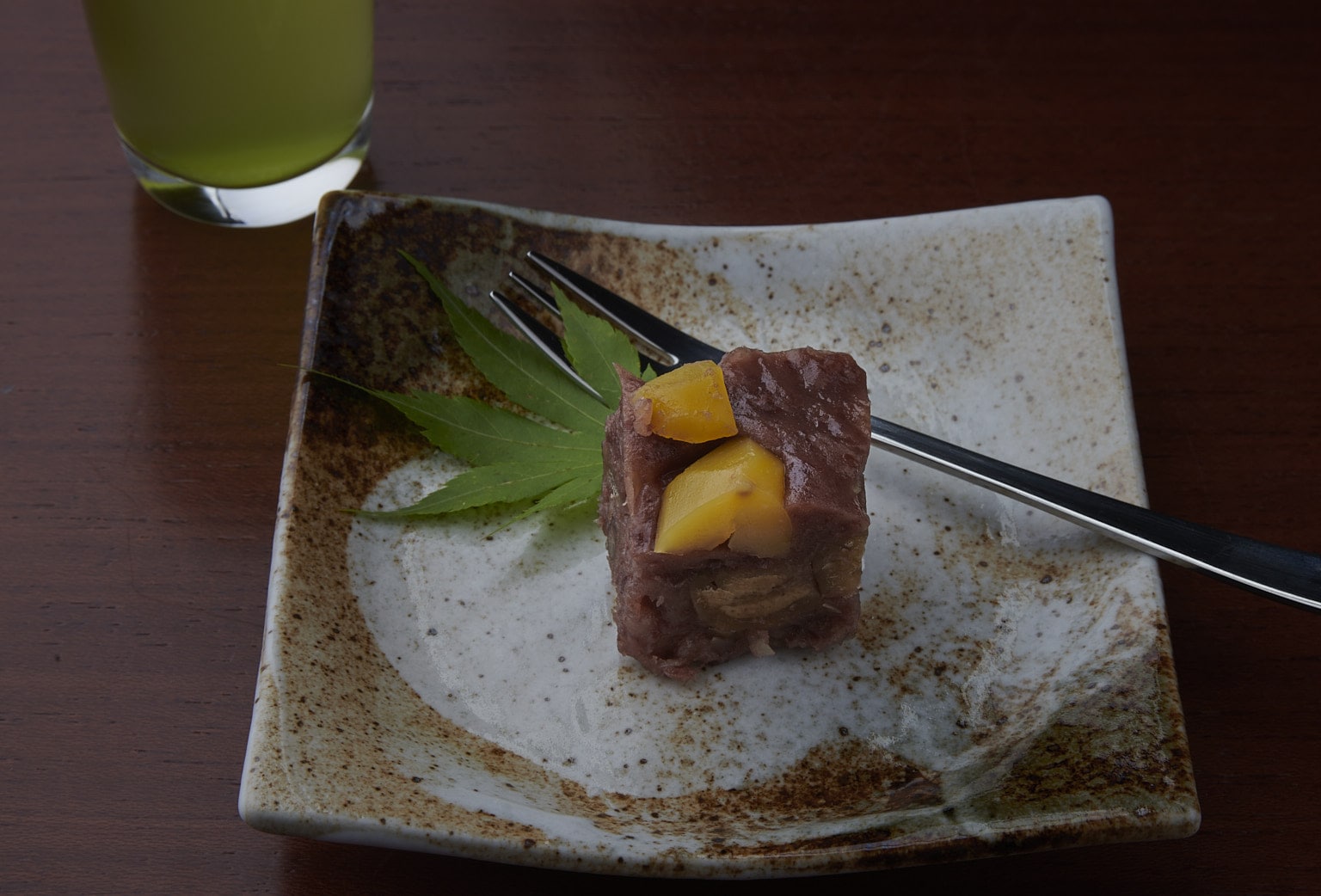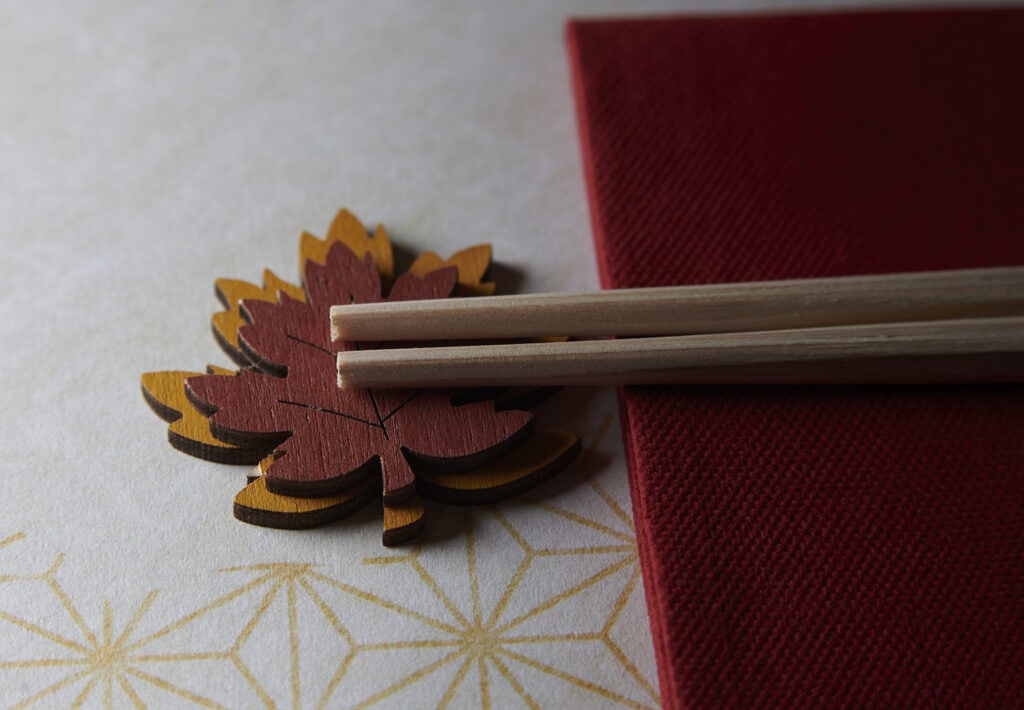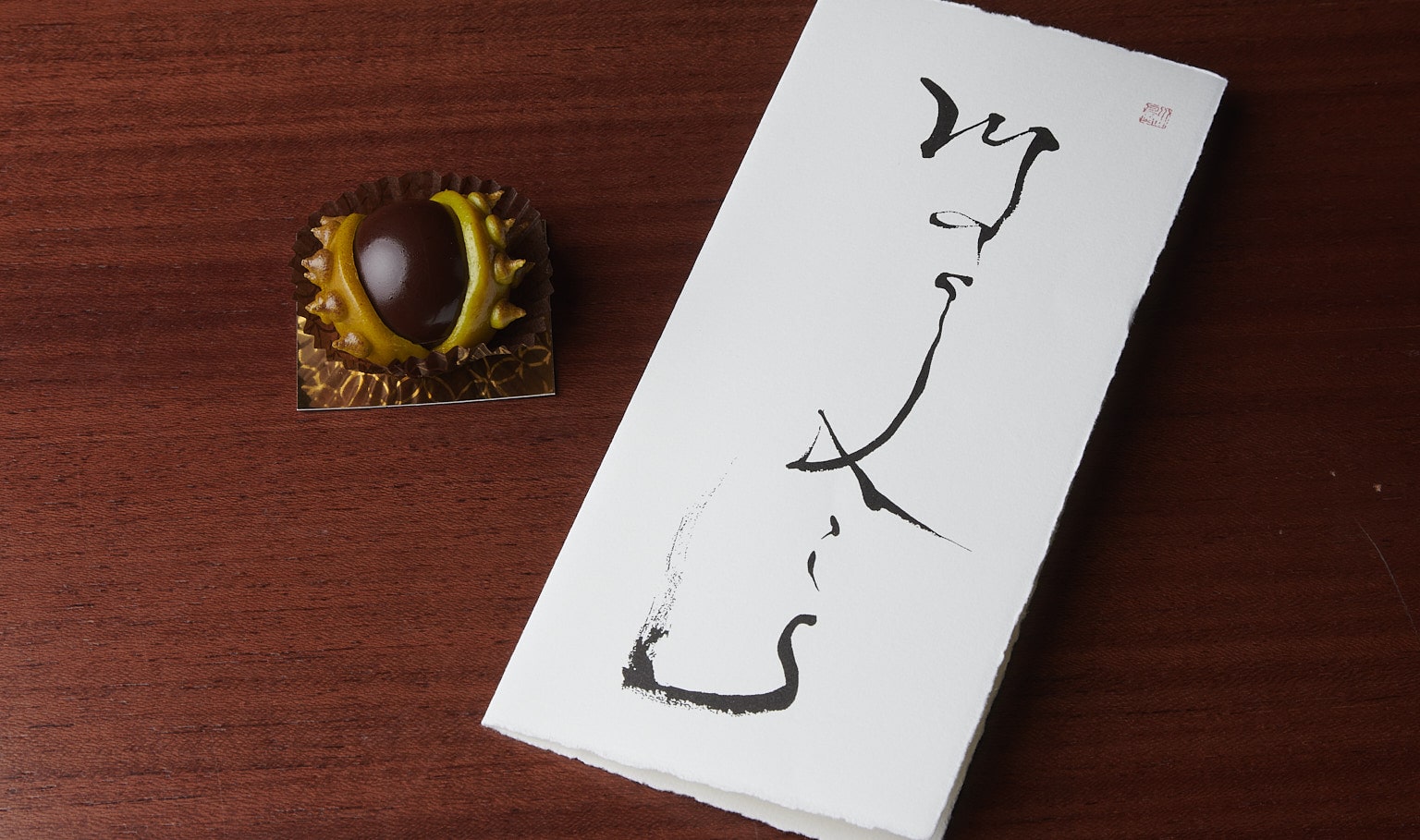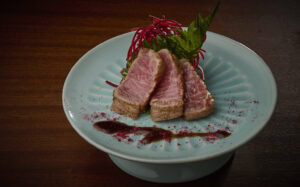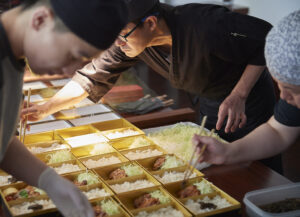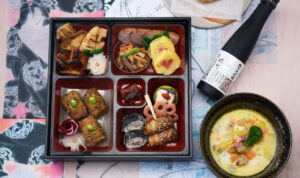Slowly the summer is coming to an end, the days are getting shorter again and a first hint of autumn is blowing through the evening.
Dew forms on the grasses in the morning and evening and autumn mackerel and mushrooms are in season.
The time is known in Japan as Kanro (寒露) and we celebrate the harvest and bounty of summer with a Autumn Kaiseki on October 19 and 20.
Here we give a small preview of the menu as far as it is already known, details may change as always due to short term availability of suitable food.
Of course, you can spontaneously choose any drink you want as accompaniment in the evening. However, we recommend booking the optional sake accompaniment, because Japanese sake is the natural, ideal companion to a Kaiseki menu and enhances the experience.
Update: the article has been updated with photos and a review of the event and the Feedback from guests added at the end.
Our first two Kaiseki events were fully booked within a very short time - reserve your place now, organizational notes & reservation link. further down this article.

What is Kaiseki actually?
Here you will find a Introduction to the theme of Kaiseki.
Here you will find the historical development of Kaiseki and why (unlike Cha-Kaiseki) it is not an ascetic monk's meal.
By the way: our articles about Kaiseki and other aspects of the Japanese cuisine are very deeply researched and often provide information you won't find elsewhere on the non-Japanese Internet.
Kaiseki Event Menu October 19 & 20, 2022 at sansaro.
Since ancient times, Japan has had a calendar concept that plays an important role in indicating seasonal changes.
The day on which the kaiseki takes place is known in this calendar as Aki-Doyō (秋土用), which refers to the day on which the new season, autumn, begins.
Japanese people traditionally pay special attention to their health by eating nutritious and tasty foods to avoid getting sick during the change of seasons. (For example, it is known that the Japanese. eat very nutritious eel dishes during the Doyō period in summer)
All the dishes we use for this menu have been carefully developed by our Chef Matsui based on this idea - hoping that our Kaiseki event in October will provide you with energy and joy for the autumn and the coming winter.

Kannazuki Hōtō Kaiseki
To thank nature for its bounty and celebrate the fall harvest, our chefs use a colorful and beautiful collection of foods from the mountains and the sea.
Here are all the courses in detail, as always, the descriptions were added gradually and in the aftermath of the event added photos of the dishes prepared for our guests.
Iwai-Zensai (祝前菜, festive appetizers)
祝前菜 豊年稲穂
焼いちじくの羽二重餡かけ、木の芽
鰻と菊芋、大葉の奉書巻き
和牛の叩き、里芋の揚げ出し、わさび
秋鮭の粽寿司
- rice ears brought from Japan with edible grains
- Hōsho-maki (eel, Jerusalem artichoke and shiso leaves wrapped with radish)
- Grilled fig with white sesame sauce and kinome
- Japanese (!) Wagyū Tataki Style, Deep Fried Taro, Wasabi
- Chimaki sushi with autumn salmon, marinated beets and yuzu
Our fall kaiseki begins with a colorful collection of seasonal delicacies to celebrate the harvest that is now being harvested.
The rice ears on the plate are a symbol of a good harvest in Japan and are shown to thank nature and pray for a good harvest next year. The rice grains are lightly fried and can be eaten.
The figs are flamed and then dressed with tofu and sesame paste.
A particular specialty is Hōshomaki, imitated from an ancient papyrus scroll. Hōshomaki is a dish prepared from grilled eel, Jerusalem artichoke and shiso leaves, which is rolled up with thinly sliced radish.
Our Wagyū comes from Kagoshima Prefecture and is classified with the best quality level A5. It is only lightly fried, raw inside and marinated in a soy sauce-based sauce accompanied with deep-fried taro and wasabi. Trace specifically also the fine own taste of the taro, whose texture and appearance makes it seem at first like a potato, but again has its own flavor in dialogue with the Wagyū, in the distance tastes Japan.
Finally, the Chimaki, which gives Japan connoisseurs a little reminder of the ancient imperial city of Kyōto, because it is typical there, Sushi marinate in bamboo leaves and press. This gives the sushi another touch. More about the different regional styles of sushi and specialties of different sushi forms soon in a comprehensive guide, which we hope to publish in November.
The tied bamboo leaf contains sushi with salmon, beets and Yuzu-shells. Because of the special way it is served with the bamboo leaf, it is called Chimakisushi.
Sake accompaniment: the colorful collection of delicacies to celebrate the autumn harvest is accompanied by the magnificent Junmai Daiginjō "Dassai 45" accompanied
This sake is brewed from the finest sake rice, Yamada Nishiki, and is characterized by its pleasant sweetness and delicious fruity aroma.
Wan-Mono (椀物, soup)
潮汁仕立て
鯛塩焼き、玉子豆腐、焼きエリンギ、絹さや
Japanese dorado is called "Tai" (鯛) and is often served as a main course on ceremonial occasions in Japan. It has a white, tender meat with a delicate flavor and is a popular ingredient in Japanese cuisine.
There are many different types of dorado, but the "Momijidai" served here is famous for its name, a reference to the seasons typical of Japan, when it is in season twice a year.
The spring-caught dorado is called "Sakuradai" (桜鯛, cherry blossom sea bream) - a pretty name because it falls during the cherry blossom period. As the name suggests, the surface of the spring dorado, which is about to spawn, is cherry red in color, giving the appearance of spring.
Dorado caught in autumn are called "Momijidai" (紅葉鯛, maple leaf sea bream) because their scales are red like Japanese autumn ubiquitous maple leaves are. The dorado has the most fat, because it takes the food to overwinter.
- Clear soup with grilled momijidai dorade, egg Tōfu, herb mushrooms and sugar snap peas
To fully enjoy the aroma of the tasty gilthead, the Junmai Ginjō "Kubota Senju" selected for its subtle aroma. This sake is a typical clear, dry sake from Niigata. Its restrained character ensures that you can fully enjoy the delicate flavor of the soup.
Tsukuri (造里, sashimi)
造里 鮪とろ焼霜、牡丹海老、帆立貝柱昆布〆
A mixture of the season appropriate individual Sashimi.
Toro Yakishimo Style
Bavarian shrimp & scallops marinated in seaweed
In Yakishimo Style, the surface is torched and cooled in cold water, removing excess fat and odors and enhancing the natural flavor of the fish.
In addition, marinated in special Konbu (seaweed from Japan) Bavarian shrimp and scallops. By simply marinating in the special konbu, without any special sauce or the like, the Bavarian shrimp and scallops get a deeper, fuller flavor.
For this we pass a Tosa-Shōyu, which is sweeter than normal Soy sauce.
Sake accompaniment: The sake "Akitabare Koshiki-Junzukuri", is characterized by its clean taste and crisp finish. It enhances the umami of each Sashimi. Sake is actually the optimal companion for sashimi, as it intensifies the umami of the raw fish.

Yaki-mono (焼物, fried dish)
焼物 秋はまちの味噌柚庵焼き、柿の白和え
甘酢茗荷、木の芽
Until the Edo period (1603-1868), it was customary for samurai and scholars to change their names when they reached the age of maturity and rose in the world. Following this custom, a fish that changes its name as it grows is called a shusse-uo (出世魚).
The shusse-uo is interpreted as a lucky fish and is often used in festive dishes to mark the beginning of a new stage in life.
Yellowtail mackerel is one of the most typical shusse-uo, the fish that have different names as they grow in size.
This saltwater fish of the wood mackerel family is called "hamachi" (魬) in Japan (up to about 40 cm in length), while those that grow up to 80 cm are called "buri" (鰤).
Hamachi, which is in season in the fall, is quite fatty and its juicy meat goes well with the sauce.
Enjoy the autumnal delicacies together with persimmon with tofu, also a fruit of the season.
roasted autumn hamachi with miso-Yūan sauce
Persimmon persimmon turned on with Tōfu
Myōga pickled in sweet vinegar
The high fat hamachi and the Junmai sake "Katsuyama En" with its strong rice flavor are a perfect match.
Age-Mono (揚物, fried dish)
揚物 秋茄子と叩き海老の挟み揚げ
れんこん煎餅、丸十の天ぷら、天つゆ
Also, the vegetables in Japan sometimes have different names depending on the time of harvest. And in addition, people also like to choose appropriate preparation methods to bring out the texture and flavor of the seasonal vegetables to the fullest.
Summer eggplants, which grow in the full summer sun, have a thick skin and a very satisfying filling, while autumn eggplants, which grow in early autumn, when the difference in temperature between morning and evening is large and the sun is relatively mild, have a soft skin and a fresh flesh with many sweet and savory flavors.
This dish offers the harmony of succulent eggplant flesh and the plump texture of shrimp, while keeping the soft eggplant skin intact.
Eggplant and shrimp sandwiches tempura
Lotus root chips
Sweet potatoes tempura
To refresh the fried food is used "Kamoizumi Umeshu", a sake liqueur made from pickled plums is served. To refresh the palate at this point of the menu, we serve the umeshu here with soda water.
Su-no-mono (酢乃物, dish with vinegar)
酢乃物 合鴨ロース煮の黄身酢かけ
舞茸としめじ茸、ルッコラ、ゆず皮のちり酢和え
- Japanese style roulette duck with egg yolk vinegar sauce
- Maitake and shimeji mushrooms, arugula, yuzu zest with ponzu soy sauce.
The beautifully colored sake brewed with peony yeast "Rihaku Caro Pink" is not regularly on our menu, but was purchased for this occasion. A rare sake brewed with black rice and peony flower yeast. The gentle sweetness of the sake and the acidity of the food create a wonderful harmony.
Tome-wan (止椀, Tome(止 means stopping - a soup served towards the end of the meal).
止椀 合わせ味噌仕立て
豆腐、青葱、なめこ茸
Tome-wan & Sushi are served together in one course.
From the aisle with Tome-Wan will be in the Kaiseki usually no more alcohol as accompaniment handed
But if you want to finish the menu with a special whisky, sake or liqueur, you are welcome to order from our large drinks menu.
Sushi (寿司)
寿司 京鯖棒寿司
白板昆布、がり、土佐醤油
Mackerel is in season from autumn to winter. To enjoy this mackerel in a way that our German guests have not often experienced, we offer Kyōto-style Bō-Sushi.
This is a very popular type of sushi among Japan lovers and Kyōto visitors that is marinated with a shiroita konbu leaf, a rare type of konbu that has been scraped very thin with a special blade.
To enhance the flavor of the mackerel, we serve it with a miso soup that has a strong miso aroma and flavor.
- Bō-Sushi (Mackerel Sushi with Shiroita-Konbu Kyōto Style)
- Pickled ginger and Tosa-Shōyu
- Miso soup with Tōfu, spring onion and nameko mushrooms
Kanmi (甘味, dessert)
甘味 栗羊羹
In Japan, sweets like cheesecake and chocolate cake that we know in Germany are also enjoyed daily.
But the traditional sweets are called "Wagashi" (和菓子) and are usually made from rice or vegetable ingredients such as beans.
There are many different types of wagashi, of which yokan is a typical example. To make Yōkan, azuki bean paste is hardened with melted agar, which is prized for its fine texture and elegant sweetness.
Many Japanese look forward to Yōkan with chestnuts in autumn. To give our guests the opportunity to experience this special treat, we have refined it with sweetened chestnuts imported from Japan.
- Yōkan (Azuki bean jelly with chestnuts from Japan)

Feedback from guests:How was the fall kaiseki in sansaro?
Any Event with us is always different, each time we approach the events with great attention to detail. The individual design gives us pleasure and when the guests notice it, we are really happy.
Richly endowed with generous feedback
The guests of the Kaiseki have again rewarded our efforts with extremely generous feedback. After all the intensive preparations that have kept the kitchen, service and management busy behind the scenes for weeks, we take the liberty (quite un-Japanese) of adorning and rewarding ourselves here with a few quotes from various guests:
"You can tell you're not just marketing, you're really putting on a fall festival for us guests!"
"Perfect as always, maybe even better".
"All the dishes were so delicate and finely arranged that it was almost too bad to eat them".
"Pairing sake and Japanese cuisine is an art that enhances and deepens the menu, you showed us that!"
"The menu was a blast! This was our second time with you and again it was phenomenal. The only real flaw was that we could only get a seat for two and not four. But your restaurant is really something special, and I hope you know that!"
Guests who think almost like Japanese
Particularly charming: a lady who was already present at our spring Kaiseki 2022 and was already enthusiastic then (and had tasted Kaiseki at Mifune in the 1980s), has even brought us noble chocolate chestnuts.
And a regular guest left us a written thank you with a very special card showing the word "Magis", painted by the Japanese calligraphy artist Misayo Kawasashima. Magis is a central concept of the spirituality of the Jesuit order and can be briefly summarized with "More depth!" or the pursuit of greater depth, quality, interdependence and creative maturity.
We like to work in depth, always have
In this respect, a highest award for us, because the work in depth, the attention to detail gives us pleasure and we are always grateful when our guests notice and appreciate this.
In doing so, we go our own way, orienting ourselves on Japanese culture as inspiration and trying to translate this for our guests in an enjoyable way. At Kaiseki we are quite classical, in the restaurant everyday life it may mean also sometimes contemporary interpretations of the Japanese kitchen or creative experiments of the respective kitchen team. In any case, it must mean the highest possible quality. This sometimes makes things unusually complicated for Western diners - but hey, that's also typically Japanese and there's a reason for that: to make the guest experience as good as possible without compromising the quality of the complex Japanese cuisine.
And the thought of Magis meets our (internal) requirements in a remarkable way. Vision that has guided us at SUSHIYA since the beginning:
Japanese cuisine is one of the most sophisticated, healthy and diverse cuisines in the world.
We present an authentic interpretation of Japanese cuisine, translating Japanese culture and thereby making enjoyment tangible and accessible to our guests.
Because good food should not only fill you up, but also make you happy. And happiness is a bridge to God.
For the public, we would perhaps paraphrase "God" today as "the divine" or simply "joy" or "joie de vivre" 😉
What remains is that we are enthusiastic about our cause and meet our guests with sincere heartfelt joy and desire that our guests experience enjoyable, positive moments with us.
So we feel seen and recognized in our efforts and in any case blessed with guests who behave almost Japanese, viz. to treat each other with appreciation and even with small souvenirs to show that they have thought of us.
Really fulfilling and a great pleasure, much more than we can expect and want to expect. Thank you very much!
Thank you and see you soon at sansaro
Always have been our exclusive events, our now legendary, always creative New Year's Eve and Valentine's Day menus are the special highlight of our work.
Besides that you can daily visit the Restaurant sansaro Order sushi à la carte in authentic Japanese quality and be surprised by our daily recommendations.
In November 2022 we will extensively revise our menu and focus even more on seasonal menus and even more precisely selected ingredients. We look forward to your visit and if you like the Subscribe to newsletterwhich will inform you immediately whenever an event is announced or becomes bookable, so that you can be part of it.
From here on, you will only find technical notes in this blog article, which have become obsolete with the execution of the event.
Reserve for the autumn kaiseki
This time we offer two days for the Kaiseki event:
Wednesday, October 19 and Thursday, October 20.
On each day there are the times 18.00h and 20.15h to choose from. At both times there is no "time limit", you can stay until about 23h, where we close the restaurant as always.
Attention: we keep the choice of seats very limited due to kitchen procedures! Do not be fooled by the fact that there are two times on two days - there are still only a total of About 60 seats on both days combined for this exclusive event!
Therefore, reserve your place as soon as possible. Should you then still want to add friends or expand, contact us promptly.
The reservations are binding, free cancellations are possible until Saturday, 15.10.22 at 10.00h. For cancellations after that there will be costs only if we can not occupy the place.
And again, a few hours after publication, both days are already reserved at 70%! Thank you for the trust!
If you can no longer get a place online, please contact us via our contact form. We will gladly put you on the waiting list or and immediately write to the customers on the waiting list in the order of receipt of their request when something becomes available (which does happen, we have already accommodated the first three groups of guests on the waiting list).
Let's stay in touch
Are you also interested in a Kaiseki event, but could not attend this time?
Would you like other events about Japanese cuisine or have special questions that the Internet does not answer?
Let us know! We are always happy to receive feedback.
And who subscribed to the newsletter will of course be the first to be informed when we have another Kaiseki event, a Sake Tasting or a Whisky Tasting or other events.
We are happy if you are interested in such events and we can always design a new menu for you for each season.
Thank you and see you soon at sansaro!

Notes on your visit to the autumn Kaiseki
Our team has been preparing everything for you for days: Decoration, food and drinks - everything should please your heart and your palate. So that we can succeed, here are a few hints to get you in the mood.

Japanese sake perfectly rounds off the taste experience of Kaiseki. Our sake sommelier has specifically selected sake to match each course, including varieties that we don't normally have on the menu.
Our recommendation: choose our sake accompaniment to the kaiseki!

Please understand that we may not be able to provide individual Intolerances or allergies can only be taken into account by omitting a dish - unfortunately, it is not possible to build up an alternative for all possible concerns with such an elaborate menu.

BPlease come punctually at the time booked for you, 18.00h or 20.15h., as the entire kitchen operations depend on it. We have a very small kitchen and for the delicate kaiseki you can not reproduce / send the courses individually. And we will be happy if you can make the occasion a appropriate clothing select

Please also check your reservation data again - if there is any change in the number of persons, please let us know right away., as we still have some guests on the waiting list - maybe then someone else can enjoy.
Above all, it would be a shame if seats were left empty, especially since the seat reserved for you is yours alone for the entire evening.
We are very much looking forward to your visit and hope that you will be as enthusiastic as the guests at our first and second Kaiseki. And if you already want to tune in, then jump again to the top of this page: we have again supplemented the descriptions of the individual dishes and courses in recent days.
